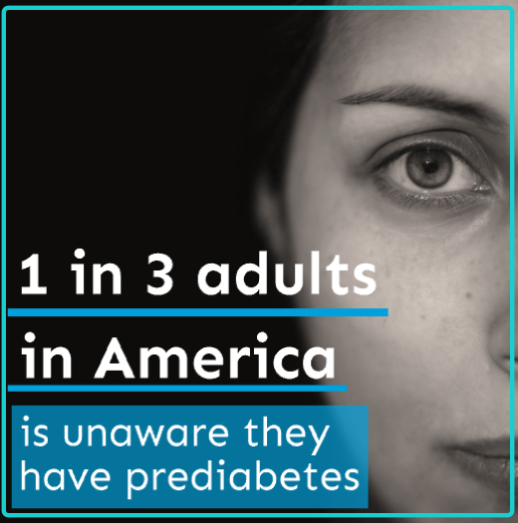The Harm in Prediabetes
Your doctor says you’re prediabetic.
So what? What does it mean?
Is it like preseason baseball (which is really just practice)?
Maybe it’s like preschool, which is all-day recess with a few rules. Not really school with homework and a teacher who can chill your bones with one glance.
Or, maybe it’s a preview of what’s going to happen to your sorry self if you don’t wake up and take care of business before you’re into full-blown diabetes.
Too harsh? Too bad.
High blood sugar speeds up cognitive decline[1]. It doesn’t have to be a super high level of blood sugar. What are classified as prediabetic levels will do it.
Our ability to reason, remember, use good judgment—all of those can start to slip when we live with high blood sugar for too long a period.
Prediabetes also increases our risk of having a stroke or heart attack or (simply) cardiovascular disease[2].
One of the most common complications of diabetes is also a complication of prediabetes. Nerve damage, or diabetic neuropathy[3]. And guess what? Nerve damage can happen not just in the feet, but throughout the body, affecting, well, pretty much everything.
Prediabetes isn’t benign. It’ll throw you to the ground and stomp on you.
It’s not OK to cruise along in a prediabetic state and just hope we don’t develop full-blown diabetes. High blood sugar is hurting us. We all need to act now to get that blood sugar down to normal levels.
[1] Science Direct, Prediabetes and diabetes accelerate cognitive decline and predict microvascular lesions: A population-based cohort study, https://www.sciencedirect.com/science/article/pii/S1552526018332497, (April 15, 2019).
[2] BMJ, Association between prediabetes and risk of cardiovascular disease and all cause mortality: systematic review and meta-analysis, https://www.bmj.com/content/355/bmj.i5953, (April 15, 2019).
[3] Science Direct, Deep phenotyping neuropathy: An underestimated complication in patients with pre-diabetes and type 2 diabetes associated with albuminuria, https://www.sciencedirect.com/science/article/pii/S0168822718307575, (April 15, 2019).
Highlights of the Prediabetes Consensus Statement
In 2008, endocrinologists got together and came out with a consensus statement on prediabetes,[1] which seems to be the most current prediabetes consensus statement from this group.
Not much has changed over the years, except for the number of people affected by prediabetes. That figure continues to grow.
You can read the statement online, but who doesn’t love the highlights-only version of pretty much anything that has 33 words in the title?
Here goes:
Introduction
There are hundreds of millions of people around the world with prediabetes.
The scary side of diabetes (stroke, nerve damage, heart disease, and so much more) seems to begin before full-blown diabetes sets in. If you’re prediabetic, you’re at risk for many of the medical complications that affect diabetics.
There are no FDA-approved medications for prediabetes. It was true in 2008, and is still true today.[2]
The Tests
The endocrinologists agree on what the blood work looks like for those who have normal blood sugar, those who have high blood sugar but aren’t yet diabetic (aka prediabetics), and those who are diabetic.
In the statement, they don’t mention using the A1C test as a first measurement of prediabetes, but it’s common to do so now. Therefore, it’s included here.
This test snaps a picture of what your blood sugar has been doing for the last two or three months. It’s called the Hemoglobin (A1C) test and is usually the first one providers use when diagnosing prediabetes.
- A1C below 5.7 percent is normal.
- A1C between 5.7 and 6.4 percent is prediabetes.
- A1C 6.5 percent or higher in tests done on two different days is type 2 diabetes.
Next is the Fasting Blood Sugar test, or Impaired Fasting Glucose test.
Blood is taken after you’ve been fasting for eight hours or overnight. You should not be active or drink anything, such as coffee, before the test that would affect carb metabolism.
- Fasting blood sugar below 100 mg/dL is normal.
- Fasting blood sugar between 100 and 125 mg/dL is prediabetes.
- Fasting blood sugar 126 mg/dL or higher (in tests done on two different days) is type 2 diabetes.
The third test is called the Oral Glucose Tolerance test, or the Impaired Glucose Tolerance test.
After fasting for eight hours or overnight your blood is tested. You then drink a sugary concoction and two hours later your blood is tested again. You shouldn’t be active or smoke prior to this test.
Note that the endocrinologists consider this test to be the more important one because it 1) identifies those who have undiagnosed diabetes and 2) indicates those who have a greater risk of becoming diabetic.
Two hours after drinking the sugary concoction:
- Blood sugar below 140 mg/dL is normal.
- Blood sugar between 140 and 199 mg/dL is prediabetes.
- Blood sugar 200 mg/dL or higher is type 2 diabetes.
Another note: The statement suggests the possibility that the higher end of “normal” is actually prediabetic because, in large population studies, physical abnormalities associated with prediabetes/diabetes are cropping up in those with high “normal” numbers.
And one more note: the endocrinologists say that prediabetes is diagnosed by either the fasting blood sugar test, the oral glucose tolerance test, or diagnosed metabolic syndrome, which is considered to be the same as prediabetes.
Get tested for prediabetes if you have one or more of these risk factors, as listed in the statement:
- Family history of diabetes
- Cardiovascular Disease
- Being overweight or obese
- Sedentary lifestyle
- Non-white ancestry
- Previously identified IGT, IFG, and/or metabolic syndrome
- Hypertension
- Increased levels of triglycerides, low concentrations of high-density lipoprotein cholesterol, or both
- History of gestational diabetes
- Delivery of a baby weighing more than 9 lb (4 kg)
- Polycystic ovary syndrome
- Receiving antipsychotic therapy for schizophrenia and severe bipolar disease
Treatment
The goal is to get blood sugar back to the normal range and treat high blood pressure and excess lipids (cholesterol and other fats in the blood) through medication. Controlling the blood sugar alone won’t automatically prevent heart disease or stroke associated with prediabetes and diabetes.
Meet with your healthcare provider to talk about where you are and where you want to be. Agree on the lifestyle changes you need to make to get you off the path to diabetes.
It boils down to:
Eat less, move more.
Cut calories, eat more fiber, go for healthy choices rather than simple carbs, which include fries, donuts, bread . . . and the list goes on. A nutritionist will lay it all out for you and help you figure out the crazy world of carbs.
You and your healthcare provider should decide if, in addition to cutting calories, drug therapy or other medical treatment is needed to help with weight loss.
Exercise, but don’t start out thinking you have to run a marathon. Your provider will suggest a safe level of exercise for you.
There is no FDA-approved drug therapy to prevent type 2 diabetes or to treat prediabetes, but your provider may decide to try some drugs off-label, depending on your risk factors. That’s another conversation you’ll need to have as you’re working on changing your lifestyle.
There’s more information in the consensus statement. A lot more, for those who love tackling sciencey jargon.
For those who prefer the CliffsNotes® version, we’re done!
[1] American Association of Clinical Endocrinologists, Diagnosis and Management of Prediabetes in the Continuum of Hyperglycemia—When Do the Risks of Diabetes Begin? A Consensus Statement From the American College of Endocrinology and the American Association of Clinical Endocrinologists, https://www.aace.com/files/prediabetesconsensus.pdf, (April 25, 2019).
[2] Medscape, What are the FDA-approved drugs for treatment of prediabetes or prevention of type 2 diabetes mellitus (DM)?, https://www.medscape.com/answers/117853-6619/what-are-the-fda-approved-drugs-for-treatment-of-prediabetes-or-prevention-of-type-2-diabetes-mellitus-dm, (April 29, 2019).
Nutrition For Prediabetics
Yulia Brockdorf, RD, LD, CDE, CST, MA, NCC, LPC, BC-ADM, is the Clinical Director of Nutrition For Success, LLC.
Ms. Brockdorf is a registered dietitian, a licensed dietitian, a certified diabetes educator, and a certified sex therapist. She holds a master’s degree in clinical mental health counseling and is a national certified counselor and licensed professional counselor, as well as holding a board certified—advanced diabetes management credential.
In her spare time, she serves as chair of the Oregon Board of Licensed Dietitians, counsels patients to explore and move through their relationship with food and nutrition, and sits on the Editorial Board for Multinational Association of Supportive Care in Cancer Journal and the Research Advisory Board with the Community-Academic Consortium for Research on Alternative Sexualities.
When asked if she would answer some questions about prediabetes and food, she said, “Sure, send them over!” She took time after work and between patients to provide thorough responses, and that valuable information is what follows.
What’s the difference between an RDN (Registered Dietician Nutritionist) and a CDE (Certified Diabetes Educator) when it comes to the dietary needs of a prediabetic?
A registered dietitian nutritionist is a professional who has an in-depth knowledge and training that pertains to all areas of human nutrition, as well as medical nutrition therapy in treatment of the disease.
A certified diabetes educator is a licensed healthcare provider who demonstrated competency and experience in treating, educating and supporting people with diabetes. This can be a licensed nurse, dietitian, pharmacist, physician, psychologist or another licensed provider (please see page 4 here).
A certified diabetes educator is required to meet nutrition competencies standards. However, their knowledge of nutrition is often not as in-depth as is that of a registered dietitian nutritionist.
When it comes to intricacies and nuances of applying nutrition recommendation, standards of practice, and latest research in practical everyday life, meeting with a registered dietitian nutritionist who is also a CDE may be beneficial for a patient.
Do you consider them equal in their expertise when it comes to instructing prediabetics on food choices?
While some providers who are CDEs gained the knowledge and mastered a sufficient skill set, in general, since there are so many professions that are eligible to become CDEs, not all will have the in-depth training, understanding of nutrition, nutrition biochemistry, and nutrition relationship between health and disease development, as most registered dietitians do. A CDE is a diabetes expert and an RDN is a nutrition expert, but most RDN training also includes an in-depth study of diabetes and prediabetes prevention and treatment.
Should prediabetics visit an RDN or CDE to get guidance on their prediabetes journey and if so, why?
Yes, they should. And oftentimes the services of a registered dietitian are covered under health insurance as preventive care. This may not be the case for all those who have CDE certification.
What is your definition of the keto diet?
The classic ketogenic diet distributes macronutrients in a ratio of 4-1. For each 4 g of fat, which accounts for about 90% of the total calories, one consumes 1 g of protein (6% of total calories) and carbohydrate (4% of total calories) combined, with protein being the more dominant macronutrient of the two. It’s very seldom that this diet is implemented in its classic form. And there are many variations of ketogenic diet currently circulating online.
What are your thoughts on the ketogenic diet for prediabetics?
Research supports caloric restriction as a means of prediabetes treatment. This may be accomplished with a ketogenic diet. I would like to emphasize that we are discussing nutritional ketosis, not a life-threatening diabetic ketoacidosis.
One of the outcomes of a ketogenic or modified ketogenic diet is a reduction of circulating insulin and an increased cellular responsiveness to insulin. A ketogenic diet can be successful in decreasing the total glucose burden in the cells of the body.
If embarking on a ketogenic diet, I strongly urge prediabetics to meal plan to ensure an adequate intake of fiber and micronutrients which may be missing when carbohydrate-containing foods that provide them are removed. Grains, for example, provide manganese, b vitamins, fiber, magnesium, and phosphorus. I do not recommend implementation of a ketogenic diet without the supervision of a trained professional.
What is your definition of a low carb diet?
This definition varies a lot from under 130 grams per day, or under 100, or between 30-60 or under 40, or below 20 (now venturing into keto world).
What are your thoughts on a low carb diet for prediabetics?
Decreasing carbohydrates does appear to have a benefit in prediabetes.
Like any diet, carb restriction will lead to weight loss and improved metabolic profiles. But research does not show that these benefits have a long-term viability.
If prudent carbohydrate intake that is both nutrient rich and portion controlled is incorporated into a long-term lifestyle change, consumption of under 100 grams a day may be a sustainable practice.
I do not support long-term carbohydrate restriction, but rather a reasonable carbohydrate intake. This number is individual for each person with prediabetes.
Is there another way of eating, besides keto or low carb, that you prefer to recommend to prediabetics?
The POUNDS LOST study looked at four diets with fat, protein, and carbohydrate distribution: 20, 15, and 65%; 20, 25, and 55%; 40, 15, and 45%; and 40, 25, and 35%. They concluded that reduced-calorie diets result in clinically meaningful weight loss regardless of which macronutrients they emphasize.
There has been a lot of research supporting the Mediterranean diet as a means to prevent diabetes and reduce blood pressure.
Plant-based diets were associated with significant improvement in emotional well-being, physical well-being, depression, quality of life, general health, HbA1c levels, weight, total cholesterol and low-density lipoprotein cholesterol, compared with several diabetic associations’ official guidelines and other comparator diets. (BMJ )
Most recently, there is an increased surge in research looking into various forms of fasting: intermittent fasting, restricted feeding, etc.
A recent study published in the Obesity journal showed that fasting not only improved postprandial glucose response (the blood sugar after eating) but also fasting glucose. Do not attempt fasting on your own without proper support. Long-term fasting may lead to death or severe and dangerous complications such as refeeding syndrome.
Is it important to have a balance between carbs, proteins, and fats at each meal or snack? Why?
It is important to consume balanced and nutrient-dense foods. Such foods would be high in necessary micronutrients such as vitamins, minerals, and various phytonutrients, while also delivering necessary energy (in the form of protein, fat, and carbohydrate).
This balance is the balance of the whole lifestyle. While each individual meal and snack can lean more toward one macronutrient or another, overall balance of food consumed in a given day, in a given span of time is important.
Including fiber will support a sense of satiety, and may help with reducing cardiometabolic risks, as well as promoting gastrointestinal health.
On the other hand, consumption of high fat and high carbohydrate foods in one meal may have a deleterious impact on prediabetes. This may result in an elevation of blood sugar, and this elevation may be sustained over a longer period of time.
As far as the balance of carbohydrates, proteins, and fats, it’s based on the lifestyle of a person and the advice of their healthcare provider. The ratio may vary.
I do advise that whichever approach is chosen, this decision is made on an individual basis and is sustainable as part of an overall healthy lifestyle.
What are your top five general recommendations for those working to reverse their prediabetes?
Don’t eat too much, and eat mostly plants
Exercise
Get enough sleep
Do things that bring joy to your heart
Spend time in nature and practice non-violence, respect, and kindness toward self and others
Which online resources for prediabetes could you recommend and share?
Keto and low carb resources:
Fasting resources:
Plant based:




